
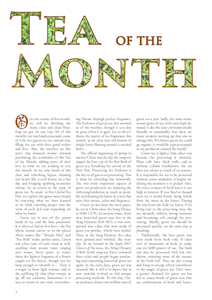 |
|

Over the course of this month, we will be drinking the nutty, clear and clean Maofeng we got on our trip. All of this month's tea was hand-processed, some of it by the guests on our annual trip, filling the tea with their good wishes and love. Also, the travelers on this year's trip donated money towards purchasing the remainder of this Tea of the Month, adding more of their love to what we are sending to you this month. As we raise bowls of this clear and refreshing liquor, cleaning our hearts like a cool breeze on a hot day and bringing uplifting mountain visions, let us return to the topic of green tea. As usual, in this Global Tea Hut, we explore the genre more deeply by renewing what we have learned so far while traveling deeper into the veins of each leaf and expanding on what we know.
Green tea is one of the purest kinds of tea, and the least processed. It is often a Chajin's first love - the Tea whose aroma carries us to the places where names like "Temple Mist" and "Fur Peak" make perfect sense. Green teas often taste of such vistas as well, recalling clear stream water singing over stones, forest pines, or sometimes the lightest fragrance of a flower caught on the breeze, though not for long enough to identify it... There is a magic in these light aromas, and in the uplifting Qi that often sweeps us up off our cushions. Sometimes it is nice to return to our roots, remembering Nature through perfect fragrance. The freshness of green tea also reminds us of the weather, though it can also be great when it is aged. Let us all celebrate the poetry of tea fragrances this month, as we stray into old dreams of bright leaves floating around a cracked bowl...
The official beginning of spring in ancient China was the day the emperor sipped the first cup of the first flush of green tea, heralding the arrival of the New Year. Preserving the freshness is the key to all green tea processing. This is done by intruding but minimally. The two most important aspects of green tea production are reducing the withering/oxidation as much as possible and shaping the leaves in a way that suits their nature, color and fragrance.
Green tea has been the most popular tea in China since the Song Dynasty (960 - 1279). In ancient times, there were loose-leaf green teas, but in the Tang Dynasty (618 - 907), it was compressed into cakes that were made of green tea powder, which were boiled. Then, in the Song Dynasty, the cakes were ground and whisked, like matcha. As we learned in the April 2017 Classics of Tea issue, the Ming Dynasty (1368 - 1644) emperor Taizu outlawed these cakes and people began producing and consuming loose-leaf green tea again. In the early days, green tea was steamed, like it still is in Japan, but as new varietals evolved so did unique processing methods. To this day, China produces almost two million tons of green tea a year. Sadly, the most mainstream genre of tea, with such high demand, is also the least environmentally friendly or sustainable, but there are many projects starting up that aim to change this. If Chinese green tea could go organic, it would be a great example to tea producers around the world!
Green tea is lighter than other teas because the processing is minimal. Plant cells have thick walls, and so without cellular breakdown, the tea does not release as much of its essence. It is impossible for tea to be processed without some oxidation; it begins oxidizing the moment it is picked. Also, the water content of fresh leaves is too high to process. If you fired or shaped such tea it would break, being brittle from the water in the leaves. During the trip from the field (or forest, if it's living tea) to the processing area, the tea naturally withers, losing moisture and becoming soft enough for processing. Ideally, green tea should be processed quickly, on the same day as plucking.
Traditionally, the best green teas were made from buds only. It takes tens of thousands of buds to make one jin (600 grams) of tea. The buds can also be processed with less oxidation, retaining more of the essence of the fresh leaf. They are also young and Yang in energy, which contributes to the magic of green tea. Over time, a greater demand for green tea has led to many kinds of green teas that are combinations of buds and leaves. In many instances, such blends or leafy green teas are inferior in quality. But as green tea has gained popularity, more regions are producing it and using many different varietals that weren't traditionally used in green tea production. Sometimes, depending on the varietal and terroir, a leaf/bud blend can actually be better than just buds, adding depth and Qi to a particular green tea.
Though green tea began in China, it spread to both Korea and Japan by the 10th century. These three could be considered "traditional" green tea, as opposed to the newer productions elsewhere.
There are many ways of processing green tea, based on local varietals of leaf and terroir - especially if we include the mastery of tea production handed down from generation to generation within our definition of "terroir." Remember, "terroir" is a French word that is generally used in discussions of wine, but it is so applicable to tea as well that most tea lovers have adopted it into their discussions of the Leaf. Terroir denotes the special characteristics of a place, found in its geology, geography, climate and even cultural heritage, which interact with a cultivated plant species to create unique expressions. Terroir is the soil and weather of a particular region; the geography and culture of the people and their relationship to the plant, and even the local microorganisms. Every place has a unique soil composition, pH, minerals and climate - all of which create a distinctive tea. When we talk about a tea's "terroir," we are speaking to the unique environment that created it, one which couldn't be reproduced elsewhere. Even if you took a grafting of a tree and cloned it elsewhere, it wouldn't be the same, since the sun would be weaker or stronger, the soil composition different, etc.
Green tea is most essentially defined by a lack of oxidation. The aim is to arrest oxidation as quickly as possible, and thereby preserve the freshness of the tea. Green tea is picked and then goes through some form of heat to arrest oxidation. This could be steaming, baking or, most commonly, pan firing. It is then dried. If the green tea has leaves along with bud, then after firing, it is rolled/shaped before drying. The rolling shapes the tea. The rolling for a green tea will always be significantly less than for other teas. All-bud green teas are not rolled - instead, they
are shaped in the drying. The most common method of drying green tea in China is to use a hot wok. Sometimes, with pan-fired green tea, the firing/rolling will be repeated a few times until the desired shape/color is achieved. The liquor of green tea can be clear to yellow or even vibrant green, depending on local variations. The Qi often enters the body through the aroma and/or mouth.
"Dragon Well" green tea from Hangzhou is perhaps the most famous of all Chinese green teas. It is pan-fired and pressed as it is dried, resulting in unique paper-flat leaves with a bright yellowish-green hue.
This tea is produced in Jiangsu. It is pan-fired into dark green curls with hints of white. Biluochun is named after the leaves, which are shaped like curled-up snails.
Despite the "white (bai, 白)" in its name, this tea from Anji County in Zhejiang Province is actually a green tea. Its name comes from the whiteness of the buds and paleness of the leaves. These long, thin, spearlike leaves are folded in a peculiar way that makes them easily recognizable.
This famous green tea from Guzhu in Zhejiang was remarkable enough to be included in Lu Yu's Tea Sutra. "Zisun (紫筍)" literally means "purple bamboo shoot," referring to the purplish hue of the buds and small leaves of this green tea.
This "Precious Eyebrow" green tea is better known in the West by its Cantonese name, "Chun Mee." It is famous for tasting subtly of plums, with a bright, tangy liquor when it is well made.
This green tea is made in Anhui, near where our Tea of the Month comes from. It is a very unique green tea in that two leaves are plucked separately to make this tea, as opposed to the bud sets that are more common in green tea production. You can read more about this tea in the March 2017 issue of Global Tea Hut.
This tea from Xinyang, Henan Province is called "Maojian (毛尖)" in reference to the furry buds (mao, 毛) and shape of the leaves (jian, 尖), which is a "sharp point." This is one of the most ancient teas still in production in the world. Maojian is one of the older types of green tea in China. Fine Maojian is made exclusively from small, sharp handpicked buds that produce a delicate, refined liquor.
"Pearl Tea" is better known in the West as "Gunpowder Tea," due to the fact that it is made up of small, rolled- up pellets that often have a smoky flavor. According to some tea scholars, this rolled-up green tea from Zhejiang Province may be the precursor to oolong tea. The highest grades were called "Pingshui Gunpowder (平水珠茶)" which means "Temple of Heaven Gunpowder." This tea is withered and steamed before drying, which means that dark, shiny pellets are usually a sign of freshness. They can be smoky due to pinewood fires near the withering tea and/or used to heat the woks during the de-enzyming, similar to Zhen Shan Xiao Zhong red tea.
"Peaceful Monkey Chieftain" tea is another Huangshan varietal. Because the medium-leaf trees used to make this tea traditionally grew in shady valleys, they have less chlorophyll and tannins, making them less astringent than most tea leaves. For that reason, larger, pretty leaves are used to make this extraordinary green tea, which is often considered the emperor of all green teas when it is well made. Traditionally, the leaves were processed in individual sets of three leaves to a stalk; this shape was referred to as "two knives and a pole (兩刀一槍)." But nowadays, stalks of Taiping Houkui often have five or even seven leaves.
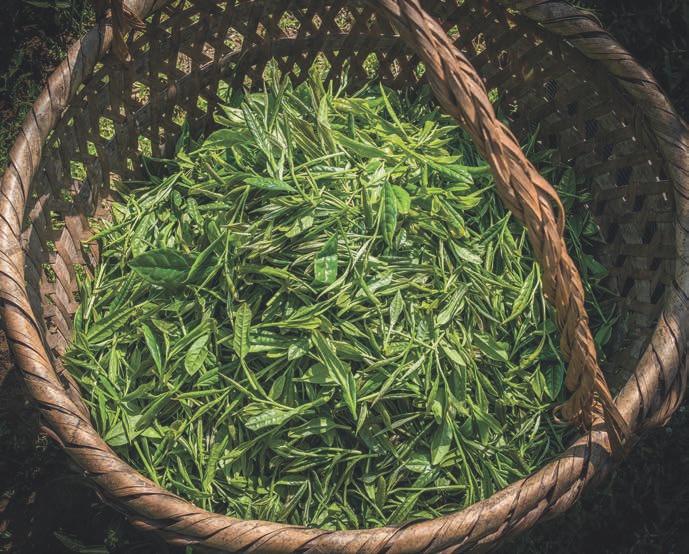
Whether the green tea is all buds, bud-leaf sets or just leaves will also determine how it is processed. The basic methods for hand-processing green tea are: pan firing, basket firing, oven baking and steaming. With the introduction of modern machinery, however, many of these steps have changed. Pan firing to arrest oxidation and de-enzyme the tea, for example, is often done in large, heated tumblers nowadays. Steaming tea is only done in Japan, which is how they arrest oxidation/de-enzyme their tea. The result is the dark green color of Japanese teas, as well as the bright green liquor and distinct flavors such teas offers.
There is great skill in processing green tea, since it is so simple. Sometimes we assume that mastery is in the more refined of the arts, but it is often the simplest things that take the greatest effort and skill. Great chefs don't need to cook with tons of spices all the time; they can also bring out the natural flavors of ordinary ingredients in unexpected ways. We once had a vegetarian chef stay at the center and he cooked up the carrots we eat regularly, only they tasted somehow more "carroty" than usual! They were delicious. And it was carrots, oil and salt - nothing else! Similarly, green tea at its finest is an expression of simple tea leaves as they are in Nature: bitter and astringent, with a transforming sweetness that lingers on the palate. And the simplicity shines when a green tea is good, like ours this month!
The pickers are masters at selecting tea, living in close harmony with Nature their whole lives. The bright farmer depicted to the right was happily singing tea-picking songs as he selected the perfect leaves for our Tea of the Month. Unbelievably, he is seventy years old, and how young he looks is a testament to mountain living and eating only organic vegetables. We asked him if he still felt young and he happily went on about how he still loved to work, to be out in the fields and under the sun. Living in a completely organic, healthy and thriving village in the mountains isn't just good for one's health and longevity, it is also conducive to happiness and prosperity. We met nothing but smiles while there. It felt like home!
In the Chinese lunar calendar, Qing Ming (清明) is an important holiday. People pay a visit to their family tombs and clean them up before making prayers. It usually falls on April 5th each year, though it wavers like the moon. The highest quality spring green teas are often Pre-Qing Ming (明前茶). The leaves that sprout just before this time are are sweeter and more tender, often with less bitterness and astringency. For that reason, they are valued in the market as the highest grades of green tea. The next highest grade is that which is produced a couple of weeks after Qing Ming, which is called "pre-rain tea (雨前茶)." The buds from this flush are also often tender, but not as tender as Pre-Qing Ming teas.
With climate change, agrochemicals and other human influences, much of the meaning and premium of "Qing Ming" is lost nowadays. Leaving aside the many fakes, different regions have very different terroirs, which means different qualities of tea. Also, what is valued by the mainstream is often based on different standards than those of the tea lover. Sometimes we value the energy (Qi, 氣) of the tea more than the flavors, especially when viewing tea as medicine. And all of this does not take into account the changes that have started due to climatic fluctuations and agrochemicals, especially chemical fertilizers, which change the time and manner in which tea bushes flush with buds in the spring.

Huangshan Maofeng green tea (黃山毛峰) literally translates to "Yellow Mountain Fur Peak" tea. We will explore Huangshan a bit later in this issue, but that part of the name is obvious. Though the tea doesn't grow in the World Heritage Site anymore, it grows in the lower foothills all around the park. Huangshan is home to several famous green teas, like Taiping Houkui (literally "Peaceful Monkey Chieftain") and An Melon Seed tea. The "fur" part of the name refers to the white hairs that cover the leaves. These hairs are a common mutation in tea, which most scientists agree is a defensive adaptation to protect the buds from insects. Most insects do not prefer tea, as it is tannic, but the buds aren't yet so bitter and astringent, and are much more palatable. The furry hairs on the buds shield them from many species of insects. These hairs make the buds more hardy, beautifully yellowish-white and also change the fragrance and Qi of the varietal, often resulting in more delicate liquor. Oftentimes, allowing for biodiversity, along with the plant's natural defenses like these hairs, is enough to ensure a large yield without the need for agrochemicals. Since insects prefer other plants, they will only choose tea when the ecology has been decimated and tea is all that remains. The "peak" part of the name "Maofeng" refers to the shape of these special leaves, which are said to resemble the jutting, craggy mountains of Huangshan, known the world over for their otherworldly spear-like spires - the kind celebrated in countless traditional Chinese ink paintings.
The travelers on this year's trip were once again afforded the chance to experience just how challenging tea-making is. Tea truly is one of the most labor-intensive agricultural products on earth. You pick and pick throughout the morning, and then take a glance down into your basket to see how you are faring, only to find that your basket is far more empty than you thought it would be - and not just by a small margin, rather more of a "That's it?" kind of feeling. It's very hard work picking tea. And actually, our green tea is much easier than many kinds of green tea in the world, because we are picking leaf and bud sets - unlike many green teas, which are composed of only buds. In fact, it can take as many as twenty thousand buds to make a single jin (600 grams) of tea! Overall, this leaves one with a deeper respect for the tea we drink. Though some of you weren't with us to experience this firsthand, you can read this issue and hopefully cultivate an even deeper and greater respect for tea farmers, and for each and every tea you serve. Knowing this, you'll hopefully respect this month's tea even more.
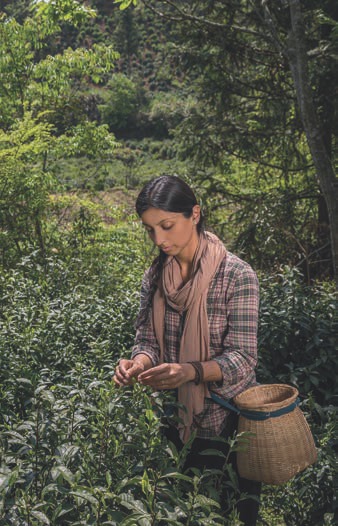
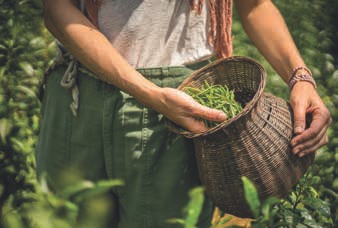
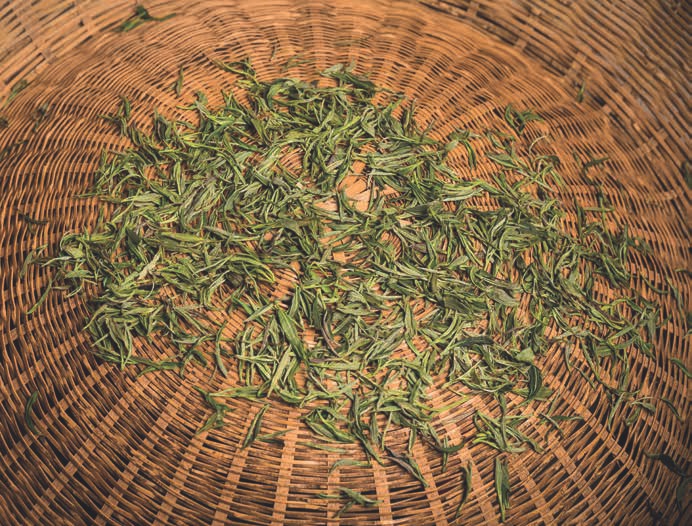

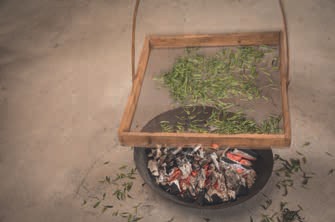
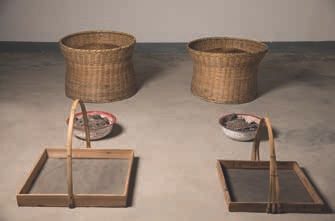
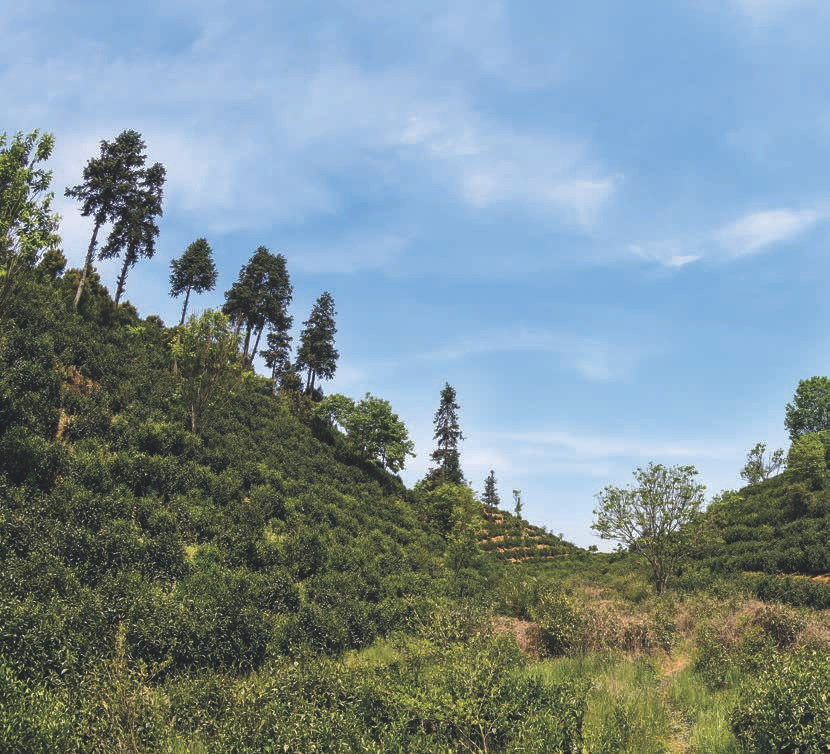
One interesting thing we learned traveling from Huangshan to Qimen, and picking red and green tea, was that different regions have different picking methods to suit the local varietals. In Qimen, the farmers squeezed and twisted, whereas the green tea pluckers were gentler, removing leaves by just squeezing. You have to pick with your fingertips or fingernails, so you don't tear the stems. You want to squeeze the stem at just the right spot. When it is done right, it comes off as if it is given. There is a satisfying squishy feeling when you have released the stem in the best way.
We started our day with prayers, offering our service to the tea bushes and asking for permission to share their medicine. And before we started picking, we asked the guests to respect the tea and remember this promise, allowing their heart to choose the proper bud sets to pick. In that way, the sensitive picker gets a real feeling that the tree is bestowing its buds on you. There is a fair energy exchange, especially in those moments when you choose the right stem and squeeze it to the perfect degree and in just the right place. We also asked everyone to try and remember that these leaves would make their way into Global Tea Hut envelopes, and try to fill the act with love. This spirit will hopefully reach your bowl this month.
Traditionally, all-bud green teas would be considered higher quality. This is true, but only in terms of flavor and aroma. An all-bud tea will usually be more delicate and fragrant, since the cells of the tea have been less affected by withering. The issue of quality in green tea can be more complicated than just buds versus leafbud sets, however, as you have to take into account the weather, the varietal and the time of year the tea is picked. There are teas that benefit from having some leaves mixed in, as it can add breadth and strength, especially if you plan to brew the tea as leaves in a bowl. (Our Tea of the Month is a higher grade, made up mostly of fresh buds.) Of course, most of the time, mixing leaves in with the buds is done for economic reasons, since it vastly increases the yield of a harvest. Green tea farmers will often have a grade that is all bud and one that is composed of bud and leaf sets, which is available at a lower cost. In our case, the choice to use leaf and bud sets was based on the fact that we would not have been able to pick anything at all if we had chosen to use buds exclusively. Also, we knew that the tea we would purchase from the farmer to blend with the tea we made ourselves would also be bud-sets, due to the high cost of all-bud green tea. Even the bud-sets from this village are quite costly, as the tea is organic and hand-processed.
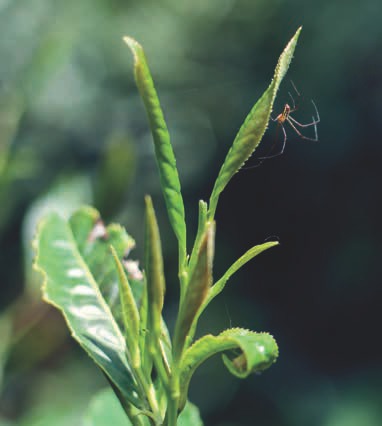


With all green tea, you want to arrest the oxidation as quickly as possible. In fact, the main difference between most other teas and green tea is withering. Other teas are withered to oxidize the leaf, but with green tea we want to arrest oxidation as quickly as possible. When larger leaves are included in a lower grade green tea, there will be some slight withering just to remove moisture from the larger leaves. Such teas are also rolled to shape them, making them more like a very lightly oxidized oolong - akin to Baozhong tea. But our Tea of the Month was very small bud-sets, so there was no withering or shaping at all. After plucking, the tea goes straight to drying. You cannot shape buds, as they are thick and juicy and would break. They are, in essence, left the way Nature shaped them.
You might wonder how the firing, or other kill-green (sha qing, 殺青), "arrests oxidation" if there is no oxidation in green tea. Well, there is always some oxidation. The moment the leaf or bud is separated from the tree, it starts oxidizing. And it will continue to do so as it sits in baskets, waiting to be taken to the processing facility. However, the aim is to keep this duration as short as possible. In Xiang Tan Cun (響潭村) village, there are only rudimentary machines for red tea production. All the green tea is processed by hand, using traditional drying methods.
The tea goes through two stages of drying, both of which use charcoal fires. The first involves gently dancing the tea leaves over a stronger flame, de-enzyming and drying them at the same time. This baking has to be done with great skill. One has to make sure the fire is not too weak or too strong, and that there is no smoke from the charcoal, which would lend unwanted flavors to the tea. The farmers use square metal mesh screens with wooden frames to move the tea over the flames, but most of us resorted to similar screens with long basket-like handles because the simpler screens got too hot to hold and were therefore much more difficult to manipulate. It was much easier to stand up and gently shake the tea with the handled version of the screen. After the tea is finished, which the farmers judge by appearance and aroma, it is taken to large bamboo baskets that are placed over milder, cooler charcoal braziers. The tea leaves are spread out over the bamboo to finish drying. This consistent, mild heat bakes the tea dry. It is then cooled on a round bamboo tray before sorting and packaging, which are the final steps.
The production of Maofeng tea in Xiang Tan Cun is simple. After all, the essence and beauty of green tea is that it is closer to the leaf 's natural state, with much less interference. By picking selectively (all buds or buds and small leaf sets), the farmers ensure that the leaves are less astringent and much sweeter than more mature leaves. Of course, tea is a bitter plant and even the buds and small leaf sets have a mild bitterness and astringency, but many of us were munching on them throughout the morning, as the bitterness gives way to a pleasant sweetness and bright energy. Tea buds and the small, new leaves around them have less chlorophyll and tannins, which is why they often aren't as green, and are therefore sweeter.
You shouldn't assume that because this tea is processed so simply that it is not made with mastery (gongfu). Of course, oolong and other more complicated teas require more skills to be produced well, but that doesn't mean that fine green tea is easy to make. It is difficult to make simple things, especially these days. To leave the nature of the leaf intact and only very subtly enhance its flavor and aroma with the gentlest of touches, while also shaping and drying the tea, is a very challenging task indeed. Sometimes, fancier food is easier to make delicious, with all the spices and sauces one needs to make rich food. But making simple salad delicious without adding too many ingredients requires skilled selection of the right produce and a delicate touch in the preparation. If this was easy, a lot more people would be drawn to eating simple, healthy food. Similarly, green tea requires its own mastery: in the selection of the right varietal, the right leaves and then in the gentle drying of the tea in a way that preserves the freshness of spring.

Xiang Tan Cun (響潭村) village was perhaps the most inspiring stop on our whole trip. As you will no doubt read about in the accounts published throughout this issue, our day there was beyond magical. We spent the first half of the day picking tea. On the hike into the mountains, we learned that the entire village has always been organic, never using any pesticides or chemical fertilizers. All their tea and vegetables are produced as they have been for centuries, and as Nature intended. And yet, the quality of the tea and food is excellent and the yield more than enough, contrary to what tea vendors who sell inorganic teas would have us believe. In fact, the lunch we had after picking tea was perhaps the best meal of the whole trip. We had handmade noodles and steamed buns with several dishes of local veggies to go with them. You could taste the vibrancy in the food, as you can in this month's tea.
The radiance of these pristine fields was so evident. All of the tea trees here are seed-propagated in a natural way, making this one criterion away from full living tea (the bushes were pruned). Not only was each bush unique, but they were all also thirty to forty years old, carrying wisdom and respect in their thick trunks. The trees were surrounded by rich biodiversity, including spiders, which are always a great sign. Only after a few years of organic farming, when the insect population has grown substantially, will spiders come and make a home there. This soil and place were rich. Remember, the terroir of tea (its environment, climate, soil, etc.) is the most important aspect of its quality. The richer the environment, the more the tea that grows there will offer. The infinite connections of biodiversity in an environment all subtly grow in influence, until the difference between this kind of natural tea and that grown in sterile, chemical-laden plantations is huge. The relationship between the insects, the animals that eat the insects, and their waste, which helps renew nitrogen in the soil, is just one of a myriad of significant factors that go into healthy tea. When tea grows naturally, without chemicals or irrigation, it learns to grow deep roots and drink of the mineral-rich soil of the mountain, and to strengthen itself against insects by growing more robust leaves. This, and all the positive, symbiotic relationships that make up a healthy ecology, make all the difference in the world - the difference between a flat, lifeless bowl of tea and a rich, uplifting and powerful bowl that takes you to the place it was grown.
In the afternoon, we sat and drank these amazing Maofeng tea leaves in a bowl. The tea was bright, crisp and clean, with a liquor that filled our insides with the spring weather of the mountains that surrounded us. This tea is incredibly uplifting and cleansing. After a few bowls, it feels like you have just showered, emerging from the session rested and renewed. Because of the pristine environment, coupled with little processing, which has left the leaves green and new, this tea fills you with birdsong, spiders, grass and flowers, and you feel like the emperor who rightly declared that spring had begun upon drinking such delicate liquor.

This month's tea is the quintessential leaves in a bowl tea. These magical leaves with some bright spring water over them are glowingly green, adding so much visual appreciation to the experience of drinking tea. Watching green tea open in a bowl is one of the great joys of a tea lover, and adds so much to the flavor and aroma. These leaves are truly gorgeous to behold. Make sure you take the time to appreciate the sensual aspects of this amazing tea, with deep and slow inhalations of the aroma, both of the leaves and in the bowl, savoring the nutty sweet flavors and taking the time to glance lovingly into the bowl.
This month, water will be much more important than other months. Of course, every cup or bowl of tea is 99% water, so choosing good spring water is essential in tea brewing. There is no faster, easier or better way to improve all your tea than choosing fine water. When drinking such a delicate, fragrant and light tea, water will play an even more pronounced role. You have to make sure that your kettle imparts no flavors to the tea. We want to enhance and encourage the simplicity and sweetness of this gentle tea. You also want to use a lower temperature of water, choosing "crab-eye" water, which is roughly 80 - 85°C. If the water is too hot, it will scald the delicate tea and some of the fragrance will be overwhelmed. You must be gentle with this tea, even in the pouring. Be sure to pour over the sides of the bowl and touch the leaves themselves with the stream from your kettle, allowing them to spin and start steeping in the first place, and to lift off the bottom of the bowl in later steepings. Though this tea is leaves in a bowl, and therefore the essence of simplicity, it should still be prepared and drunk with a bit more upright grace. And that should be reflected in your chaxi, the water you choose, the way you pour and even the way you sip this ethereal tea.